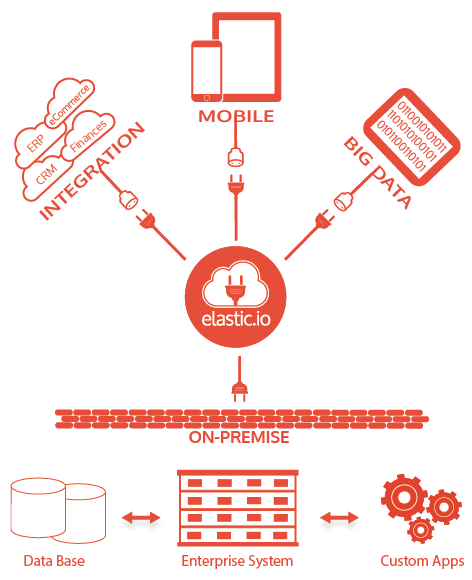elastic.io provides developers with a complete integration suite of tools and technology that make connecting disparate software easier, less time-consuming and more cost-effective. elastic.io belongs to the generation of the so called “cloud-born” companies and is, therefore, ideal for integration of SaaS, but it also offers an on-premise version for more complex enterprise architectures. Below is our interview with the CEO and Founder of elastic.io, Renat Zubairov:
 Q: Could you explain the function and advantages of your integration platform?
Q: Could you explain the function and advantages of your integration platform?
A: Our platform includes all functions that any other classic iPaaS does: It comes with the necessary tools and technologies to develop and manage integrations, execute and monitor integration flows. Our integration platform can be implemented in any use case that involves connecting cloud-based software applications with each other and with on-premise systems to enable automated data exchange. Why is this important in the first place, you might ask.
Well, let me give you a quick example. Imagine you have an online shop. Instead of manually monitoring your stock levels and writing invoices for every purchase, wouldn’t it make your life much easier if a special software automatically records the number of items sold, notifies you in time that you have only a limited number of items left and need to re-order goods, and pushes every new order to another software to generate an invoice that is then automatically sent to the buyer? Yep, it definitely would make your life easier.
Speaking of the advantages of the platform, without going too much into technical details, I think it is the uniform infrastructure for all integrations. I’ll explain. One of the main problems that most integration experts face is that every time they connect two or more applications, they do this in an entirely new environment, in other words infrastructure. Therefore, even if it is about same repetitive integration scenarios, every next integration project has to be done from scratch all over.
A uniform infrastructure of an iPaaS solves this problem: Integration components need to be built only once for all end users. The only thing that is left to be done is to do a project-specific mapping between the components. This approach saves time, money and development efforts in the long run immensely; some of our clients reported the reduction in overall efforts by about 80%.
 Recommended: Codisto Offers A True Next Generation eBay Integration Experience For Magento
Recommended: Codisto Offers A True Next Generation eBay Integration Experience For Magento
Q: What advantage does elastic.io have over its competitors?
A: Well, first of all, we provide developers not only with the tools for building integration flows, but also with the tools to create integration components in the first place. Here’s what I mean: Imagine a company that is using Salesforce as CRM, Dynamics Navision as ERP and an in-house developed accounting software. Let’s say they decide to use our platform to integrate all three with each other. They can take our pre-defined component templates (which we, by the way, deliver together with the platform) for Salesforce and Navision, but obviously, there is no template or connector for their custom-built application. So, in this case, they can build their own connector, or as we call it, ‘integration component’, themselves with our Software Development Kits for multiple programming languages.
Next, the elastic.io integration platform as a service is currently the only one that is built on Docker technology. Therefore, by definition, it supports the microservices architecture that promises to become an industry standard for building applications. This also ideally fits into the overall concept of reusability without which our platform is unthinkable: Our framework basically forces developers create integration components that can be used over and over again and easily replaced by each other. This is essential for what the integration platform is there for – reducing time and efforts within the scope of integration projects.
Last but not least, we also offer our platform as White-Labelled iPaaS. This means that enterprise IT or system integrators can take our platform and build ready-to-use integration solutions on top of it, offering them to the end users under their own brand. Such integration solutions can be even delivered as internal integration marketplace.
PIC Recommended: PeopleLinx – The World’s Most Comprehensive Solution For Social Selling
The opportunities of a white-labelled integration platform are vast. If the readers are curious to learn more about them, they can check out the two white-papers on the White-Labelled iPaaS, which they can download on our website.
Q: What were the main challenges you faced in developing the company?
A: Maintaining the focus were and is the main challenge when building a startup. Every startup is getting loads of conflicting advices. Advices from experts, people who’ve done this, people who have heard about this and people who just have a strong opinion about something. And at the beginning, founders have to do everything and keep an eye on many things simultaneously. That’s complicated and distracting from delivering great customer value and building a great product.
Q: What can we expect from elastic.io in next six months?
A: We are living in exciting times. The move to the cloud and raise of the SaaS is once-in-a-lifetime change. The impact that this will have on the business software could be somehow comparable with invention of the movable type and the printing press . What we are witnessing now is a digitalization of the business that is only possible with democratization and consumerization of the software. Integration software will also be affected – according to Gartner, by 2017, at least 65% of new integration flows in large organizations will be developed outside the control of IT departments. And this kind of work will require new tools.
Right now we have the most scalable and advanced cloud-native integration platform on the market, and for the next 6 month we plan to significantly improve the UX/UI of our product to adopt it to the new ‘consumer’ / ‘citizen’ driven realities.
 Recommended: Meemim – Enterprise Wiki Platform Designed For The 21st Century
Recommended: Meemim – Enterprise Wiki Platform Designed For The 21st Century
Q: How would you convince the reader to start using elastic.io?
A: If you’re a developer dealing with integrations regularly, than you know how tedious, time-consuming and complex they can be. We offer tools to build such integrations faster and monitor integration flows and data exchange down to the last detail. If you’re a product manager or in Business Development looking for ways to relieve pain points related to insufficient communication between disparate software or to streamline internal business processes, our platform is for you too.
Just give it a try, and we truly believe that your first experience will convince you to stick with the platform.
Activate Social Media:


